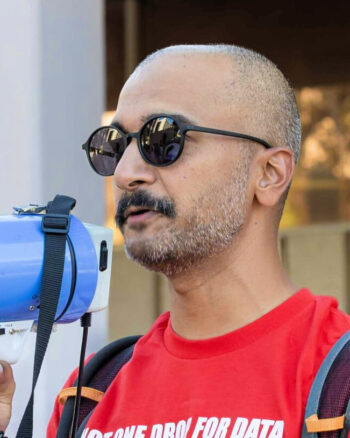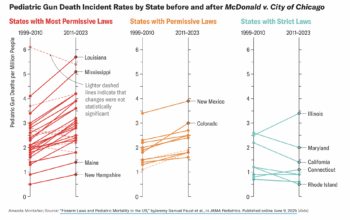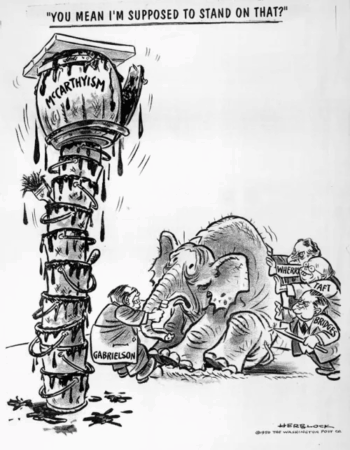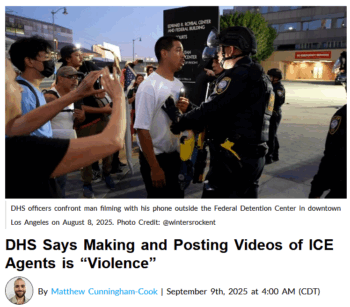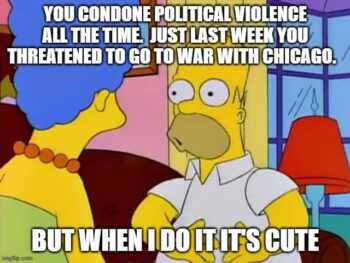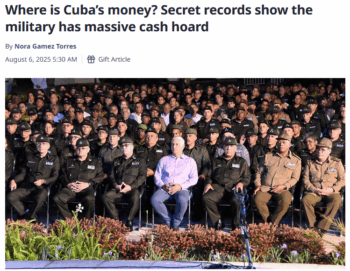
Planet Money promises, “See the world through the lens of an economist and you’ll start to feel a little less overwhelmed when making financial decisions.”
For six seasons now, NPR’s Planet Money, the network’s economics and finance program, has aired a Summer School miniseries that offers its audience a “crash course in economics for your ears.”
Presenting listeners the opportunity to “see the world through the lens of an economist,” the program has spent summers covering topics including microeconomics, investing, macroeconomics, business administration and economic history.
This year, Summer School is covering political economy, the interdisciplinary social science that examines the state’s part in shaping the economy. Though NPR claims that its programming is “diving deep into the waters” of the discipline (NPR, 7/15/25), its shallow coverage offers just one answer to the question, “What role can or should the government play in shaping the economy?”
Under the guise of general education programming, Summer School sidelines critical perspectives and represents neoliberalism as consensus to teach its audience that privatization, austerity and deregulation are pivotal to freedom and prosperity.
‘Why are countries rich and poor?’

Planet Money (7/15/25) asks the question, “What role can or should the government play in shaping the economy?”
In episode 1, Summer School 2025 host Robert Smith set the stage by asking his guest, MIT professor and former IMF chief economist Simon Johnson, “Why are some countries rich and some countries poor?”
It’s a question that Johnson is well-equipped to answer, having just recently won the Nobel Memorial Prize in Economic Sciences for analyzing the long-term outcomes of what he and his co-authors, Daron Acemoglu and James A. Robinson, have termed “extractive” and “inclusive” colonial institutions. “Extractive” institutions politically and economically disenfranchised colonial subjects, they argued, while “inclusive” institutions offered the population greater political representation and a larger share of accumulated profits.
The difference highlights the importance of democratic access to resources, like capital and land, to economic development—but in his NPR feature (7/9/25), Johnson was instead quick to point the finger at “expropriation”: “We don’t think enough about expropriation and extraction, which means somebody can steal your stuff.”
Treating it as a virtual synonym of “extraction,” Johnson characterized expropriation—the process in which the state takes private property for public benefit—as an inherently negative act in which “powerful people…come and take our stuff away.”
‘Somebody can steal your stuff’

Planet Money‘s answer (7/9/25) to the question of the proper role of government: “I need to know that if my business is successful, it’s not going to be suddenly taken away from me.”
Johnson’s framing—“your stuff” and “our stuff”—encouraged his audience to identify with a successful capitalist having his business taken away; it assumed that listeners have more in common with an expropriated capitalist or landlord than with the landless beneficiaries of redistribution. Expropriation as a barrier to prosperity was framed as common sense: As Smith explained in his introduction, “I need to know that if my business is successful, it’s not going to suddenly be taken away from me.”
In broadening the definition of extractive institutions to when the authorities can “steal your stuff” and “take what they want,” the difference between “inclusive” and “extractive” institutions is no longer democratic access: Expropriation has been used in various places to democratize access to land and capital.
In China, redistribution facilitated the land reform and central planning that transformed China from one of the poorest nations in the world to the world’s second-largest economy.
Land reform and state-driven development also played key roles in the “East Asian Miracle”—the rapid evolution of the “East Asian tiger” economies of Hong Kong, Singapore, South Korea and Taiwan—from underdeveloped colonies to high-income states. Of particular relevance is the case of Singapore, a state that maintains majority stakes in key capital industries to invest in education, maintains ownership of most land to reinvest rents and develop quality public housing, and forces capital to share amenities with the public—all contributing to a high standard of living and an urban-renewal success story.
NPR centered the plight of entrepreneurs over those with no access to capital, and wholly reframed redistribution as theft—a stance that explicitly favors protecting private property over democratizing access to resources.
‘In a place like North Korea’

North Korea’s actual record of decades of rapid growth followed by crisis (Monthly Review, 3/24) presents a more complicated picture than Planet Money‘s caricature of a country where when “somebody tries to build something, if the ruling elite wants it, they just take it.”
Johnson went on to list expropriation in North Korea as a case study of extraction, observing that while the North Korean ruling class lives “reasonably well,” “most people in that country are immensely poor and sometimes actually starving.” He explained that this is because
anytime…something good happens to an entrepreneur…if the ruling elite wants it, they just take it. The ruling elite in a place like North Korea extracts all the value from the people.
But expropriation alone cannot account for poverty or hunger in North Korea. In the decades following decolonization, expropriation allowed North Korea to effectively urbanize and industrialize, producing enough grain to feed its population and even export some grain in 1985, despite a rugged, mountainous terrain inhospitable to farming. As John Jay College economics professor Zhun Xu wrote for Monthly Review (3/24):
By economic measures, North Korea had an impressive first three decades or so. Its GDP per capita grew at 4.5% annually between 1950 and 1980…. Thirty years after the civil war, North Korea had achieved a high level of urbanization and industrialization…. North Korean agriculture was also successful, at least for a while…. Between 1961 and 1980, its cereal output increased by 4.8% annually.
An honest analysis of North Korea’s political economy would account for a number of factors prior to and following the famine in the 1990s: Rapid agricultural automation leaving North Korea reliant on foreign petroleum, rapid urbanization depleting the reserve of agriculture workers, low export competitiveness in the face of neoliberal globalization, and, perhaps most critically, the deadly US sanctions regime.
But by pinning blame for poverty in North Korea solely on expropriation, Johnson builds an undue association between redistribution and failure, wherein poverty exists because of a lack of private property protections.
‘Help poorer people help themselves’

Planet Money (1/28/15) brought on economist Hernando de Soto to present a glowing picture of his austerity program for Peru.
Smith then introduced a counter-example: Neoliberal reforms instituted in Peru in the 1990s under CIA-backed dictator Alberto Fujimori, under the guidance of economist Hernando de Soto, who “saw these extractive institutions we’ve been talking about and decided to do something about it.”
Referencing a 2015 Planet Money profile (1/28/15) of de Soto, Smith and Johnson argued that reforms aimed at building the middle class worked by cutting red tape to expand access to credit and capital—making it easier to have a title to a home or business, allowing “a lot of poorer people” to “help themselves.”
The reality of these reforms, however, is more nuanced. While Fujimori’s reforms did curb inflation and promote growth by attracting investment (CNN, 4/28/99), property-titling reforms did not improve poor Peruvians’ access to credit, nor did they increase mortgage lending. (Mortgage lending only increased when the state began subsidizing low-income mortgages in the 2000s.)
Instead of democratizing access to credit and capital, the de Soto program eroded the power of organized labor: Under the Fujimori regime, labor leaders and unionists were arbitrarily detained and tortured, unions shrank by a third, and Peruvians began to work longer hours. Privatization of large swaths of federal functions successfully attracted foreign investment, particularly in mining, but multinational corporations made little contribution to the local economy, extracting natural resources while degrading the environment.
While formalization of private property protections did promote economic growth overall, it did not actually empower people by giving them access to capital: As an austerity program, it pushed Peruvians to work harder while their resources were plundered, their public services were gutted and their unions were crushed.
‘Who are regulations protecting?’
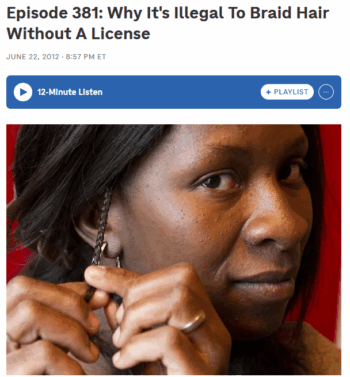
The original Planet Money report (6/22/12)—unlike the Summer School excerpt—acknowledged that Clayton v. Steinagel was brought to the Supreme Court by the libertarian Institute for Justice.
Though not every episode of the series was as explicit in calling expropriation theft or glorifying austerity as democracy, later episodes similarly used a small-business framing to make arguments against state intervention. For instance, episode 4, “Who Are All These Regulations Protecting?” (7/30/25), presented an anti-regulation argument through a case study of a small-business owner who couldn’t afford licensing.
Smith introduced the story with a short clip from a 2012 Planet Money profile (6/22/12) of Jestina Clayton, a Sierra Leonean–American braider who shut down her business after learning that all aestheticians in Utah must be licensed. Her case was presented as a social justice issue—a traditional African braider who couldn’t afford $16,000-plus tuition to go to cosmetology school.
Dismissing a trade group spokesperson’s concerns that unlicensed aestheticians can harm consumers, Smith and his guest, political scientist Joan Ricart-Huguet, discussed Clayton’s case as one in which industry has captured regulation, leveraging its moneyed interests to prevent competition. They framed deregulation as the equitable solution, leveling the playing field for small businesses like Clayton’s.
But Smith failed to mention the interests behind Clayton’s case.
Clayton v. Steinagel was taken up by the Institute for Justice (IJ), a Koch-backed libertarian law firm and partner of the State Policy Network, a right-wing, anti-union, libertarian coalition that also includes the Cato Institute and the Heritage Foundation. Among IJ’s largest donors are billionaires and corporate money managers, who have vested interests in the various deregulation causes that the IJ takes up, most prominently successful advocacy for weakening campaign financing laws—which contributes to the revolving door that gives industry greater sway in the regulatory process.
Deregulation is not the opposite of regulatory capture, as presented in the episode: They’re both consequences of moneyed interests undermining state oversight. Yet listeners are presented with the impression that deregulation is capture’s just alternative.
‘Temporarily embarrassed millionaires’

FAIR’s Peter Hart (8/17/12): “Even if you’re not an expert in media ethics, you’d probably agree that a show about finance and business exclusively sponsored by one giant bank has an obvious conflict.”
Planet Money Summer School 2025 wasn’t all bad, including very instructive breakdowns of progressive taxation (7/16/25) and US federal budgeting (7/23/25), and case studies of tariffs (8/20/25) and industrial policy (8/6/25), but nonetheless, programming had a blatant neoliberal bias.
This much is unsurprising: FAIR has previously covered Planet Money’s proclivity for austerity (6/1/13) and NPR’s beholdenness to corporate interests (6/27/15, 7/2/15). Of particular note is the conflict-of-interest controversy Planet Money faced during the Great Recession, when the program was less than a year old: Planet Money’s sole corporate sponsor was Ally Bank, a subsidiary of the bank holding company formerly called GMAC, which was heavily implicated in the subprime mortgage crisis (FAIR.org, 8/17/12).
Paraphrasing novelist John Steinbeck, Ronald Wright noted in A Short History of Progress that the American poor “see themselves not as an exploited proletariat, but as temporarily embarrassed millionaires”—and it’s this attitude that Planet Money capitalizes on to glorify austerity and deregulation.
Instead of framing the state as an institution that can do good for most people, Summer School spent this season convincing its audience that the most good that a state can do is to protect the accumulation of private property—and that any alternative is tantamount to theft and a barrier to our collective prosperity.
This post was originally published on FAIR.

